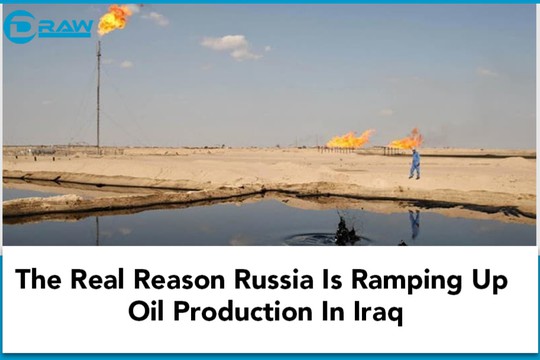Russia takes control of Iraq’s biggest oil discovery for 20 years
Preliminary estimates suggested that Iraq’s Eridu oil field holds between 7-10 billion barrels of reserves. Senior Russian oil industry sources spoken to exclusively by OilPrice.com said the true figure may well be 50 percent more than the higher figure of that band. In either event, the Eridu field - part of Iraq’s Block 10 exploration and development region – is the biggest oil find in Iraq in the last 20 years, and Russia wants to control all of it, alongside its chief geopolitical ally, China.
The approval last week by Iraq’s Oil Ministry for Inpex – the major oil company of key U.S. ally Japan – to sell its 40 percent stake in the Block 10 region that contains the huge Eridu discovery leaves the way clear for Lukoil to take total control of the entire oil-rich area.
Block 10 lies in the southeast of Iraq, approximately 120 km west of the key oil export route from Basra, and just south of the huge oil fields in and around Nassirya.
Back in 2021 – at least before the U.S. formally withdrew from Iraq by ending its ‘combat mission’ there at the end of December – it was clear that Washington knew what Russia and China were up to long term in the country, and how the U.S. was being manipulated by Iraq. In a moment of insight, the then-U.S. Deputy Assistant Secretary of Defense, Dana Stroul, said: “It’s […] clear that certain countries and partners would want to hedge and test what more they might be able to get from the United States by testing the waters of deeper co-operation with the Chinese or the Russians, particularly in the security and military space.” This view could equally have been aimed, not just at Iraq, but also at most other countries in the Middle East at that time - most notably Saudi Arabia, and the UAE. That said, this profound insight had no effect on Washington at that point, and posed no impediment at all to either Russia or China’s continued drive to entirely push the U.S. out of the Middle East, as analysed in depth in in my new book on the new global oil market order.
Multiple field exploration and development deals, plus countless lower-profile ‘contract-only’ agreements, with Russian and Chinese firms allow the two countries plenty of scope to leverage these out into a harder geopolitical presence across the country, including into the very fabric of its key infrastructure.
These plans, in turn, link into corollary plans by Russia and China to turn the entire southeast region of Iraq - that culminates with the major oil export hub of Basra - into a region criss-crossed by Russian- and Chinese-controlled oil and gas fields and transportation hubs.
Brazil gears up to become fourth largest oil producer
 Photo: OilPrice
Photo: OilPrice
Brazil's National Agency of Petroleum, Natural Gas and Biofuels (ANP) reports that the country's oil production is steadily increasing, projecting the country to become the world's fourth largest oil producer, informs OilPrice.
The country's large reserves, particularly pre-salt reserves, coupled with a rise in exploration and drilling activities, underscore the potential for significant production expansion.
Despite concerns over government intervention and taxation, foreign energy companies like TotalEnergies and Equinor continue to invest heavily in Brazil, signalling the country's strong position in the global oil industry.
Data from Brazil’s hydrocarbon regulator, the National Agency of Petroleum, Natural Gas and Biofuels (ANP – Portuguese initials), shows that for April 2023, the country pumped an average of 3.1 million barrels of oil per day. That number is almost 1% higher than a month earlier and 5% greater year over year. Total hydrocarbon output for April 2023 amounted to just over 4 million barrels of oil equivalent per day which was 1.1% higher month over month and 4.4% greater than a year earlier.
That growth indicates Brazil possesses the potential to become the world’s largest oil producer, especially when it is anticipated the country 2023 will add 300,000 barrels per day, taking production to 3.4 million barrels daily by the end of the year.
During 2022, Brazil was ranked ninth globally by oil production, ahead of Kuwait and behind Iran, lifting an average of just over 3 million barrels per day. Suppose Latin America’s largest economy is to become the world’s fourth-largest oil producer.
Another key aspect that will support those plans is Brazil’s copious hydrocarbon reserves. According to the ANP, at the end of 2022, Latin America’s largest oil producer held proven or 1P petroleum reserves totaling 14.9 billion barrels, of which 77% were categorized as pre-salt. There are also 21.9 billion barrels of proven and possible or 2P reserves and 27 billion barrels of 3P reserves, known as proven possible and probable reserves. This illustrates that Brazil possesses considerable hydrocarbon potential and the reserves required to support a significant increase in oil production. Those reserves will keep growing as exploration and development drilling gains momentum, with the Baker Hughes International Rig Count showing 17 active rigs at the end of May 2023 compared to 11 a year earlier.
In January 2023, French supermajor TotalEnergies approved the $1 billion final investment decision, or FID, for Lapa South-west offshore oil project in the Santo Basin, Brazil.
In early May 2023, Norwegian energy supermajor Equinor announced that it, along with partners Repsol Sinopec and Petrobras had approved the FID to proceed with the $9 billion development of the B-M-C-33 project in offshore Brazil.
Brazil remains an attractive jurisdiction for foreign energy companies despite President Lula's hiking oil industry taxes and the growing risk of increased government intervention.
read more in our Telegram-channel https://t.me/The_International_Affairs

 10:20 04.12.2023 •
10:20 04.12.2023 •























